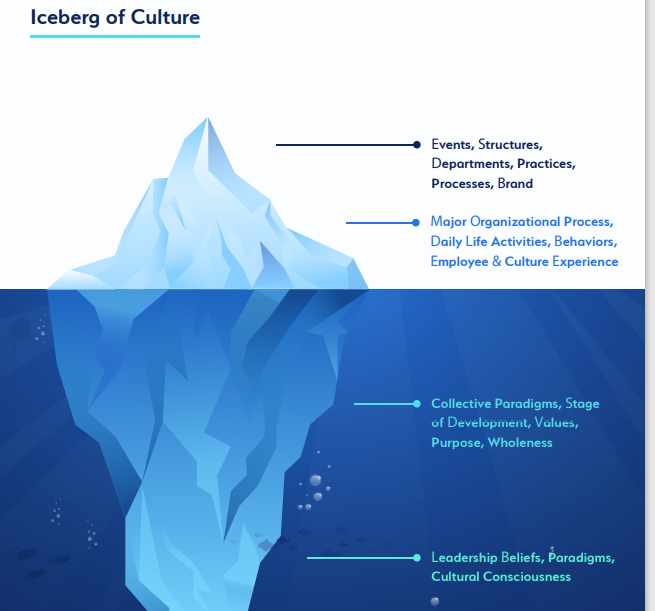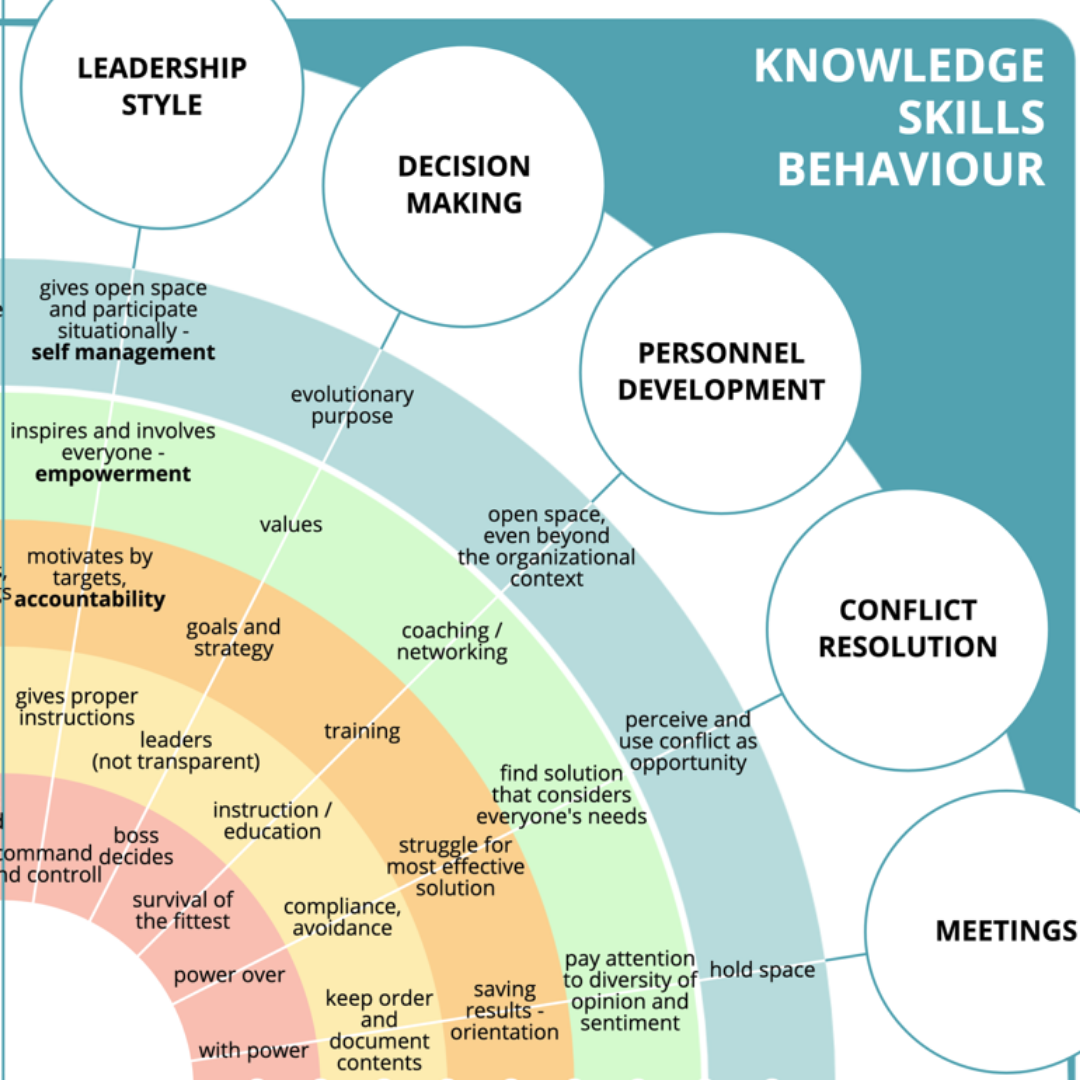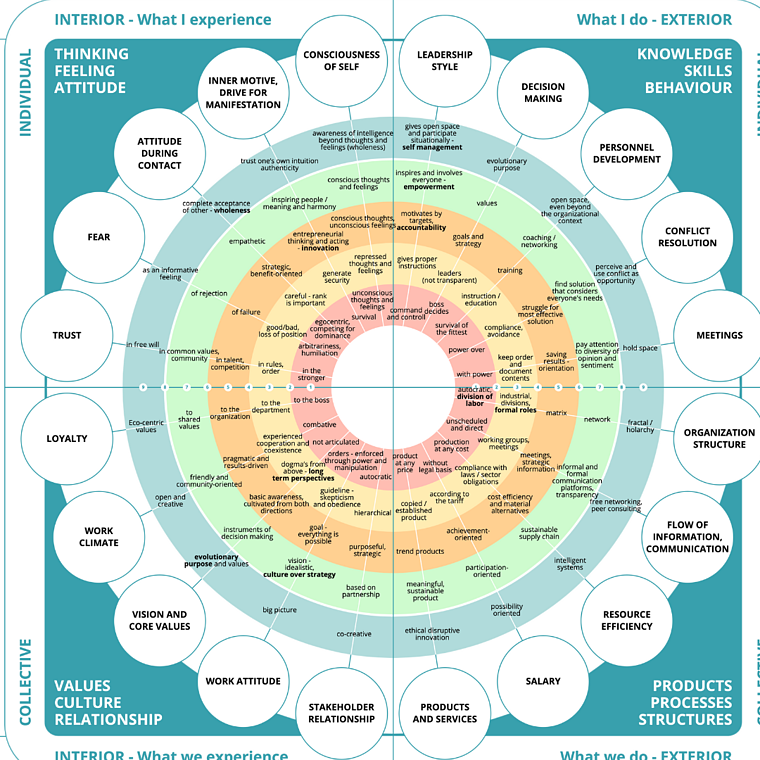When developing new strategies for your team and company, you should first ask, “Is our culture capable of…?
Systemically assessing foundational and transformational needs and priorities is essential to managing your culture to support new strategies, meet business objectives, and innovate for the future. By understanding the current state of your culture, you can identify gaps that must be closed to evolve to your desired future state.
If you have seen our “iceberg of culture” image in the past, you would have learned how leadership beliefs, worldviews, paradigms, and the level of cultural consciousness are the true root causes of any organization's culture. That being said, in order to understand what you need to do to evolve into the culture you desire, you must understand what paradigm you are currently operating from.

By understanding the current paradigm you are operating from, you will better understand the state of your culture, and you can properly identify gaps that must be closed to evolve you into your desired future state. It’s also important to remember that operating from a certain paradigm does not mean something is broken. It’s more about understanding what is possible. It’s inviting you to find new ways to make an impact and create deeper levels of purpose.
In order to evolve your own cultural paradigm, you need to start asking yourself, is there a more powerful, more soulful, and meaningful way to work together?
Is it our worldview that is limiting the way we think of our organization and is it time we start to change our own belief system?
What does the next cultural paradigm level look and feel like?
There is nothing inherently “better” about being at a higher level of development, just as an adolescent is not “better” than a toddler. However, the fact remains that an adolescent is able to do more, because he or she can think in more sophisticated ways than a toddler. Any level of development is okay; the question is whether that level of development is a good fit for the task at hand.”
- Nick Petrie (Center for Creative Leadership)
With each level of cultural development, everything changes, including the top layers of the iceberg.
There are a few key values that we hold onto within this model:
- We do not speak of types of people, but of types in people
- All levels make their unique and important contribution to the evolution and deserve full appreciation (no rating)
- How people think is more important than what they think.
- Why they do something is more important than what they do.
The typical cultural paradigms that organizations operate by...
.png?width=1600&name=image%20(7).png)
Level 1 - The “Traditional” View
Since the beginning of societies appearing, the role of the “chief” emerged to enforce social order, and in many cases, could utilize brutal force if needed to maintain it. From research and any general sense of awareness, we know people in this paradigm operate from an impulsive and egocentric manner. At this level, everything is seen through a lens of power. If we are looking above the waterline on the iceberg of culture, you will find a hierarchical pyramid with top-down command and control. There will be clear ranks that stack up in the pyramid that are all designed to drive a world of stability and certainty. Your people will be glued to the organization through loyalty and the fear of the chief. The leaders will also implement major organizational processes and systems, including rules of what is right and what is wrong. With this type of rigid structure, when the world changes, these types of organizations find it extremely difficult to accept and change as well. Organizations that are typically found in this living paradigm, are the military, government agencies, school systems, and universities.
Typical Values found in this stage:
- Formal roles with hierarchical pyramid
- Hierarchy & Control (Traditional Awareness)
- Top-down command and control
- Future is a repetition of the past
- Processes
- Rules and group norms
- Conforming to social norms
Stage 2 - The “Champion” View
This is a paradigm that dominates most management thinking today. It’s often the model students learn in business schools all over the world. This paradigm has transformed societies all over the world in recent history from the traditional worldview in Stage 1. When thinking about what type of organizations operate in this stage, think about publicly-listed corporations. These organizations are in ruthless pursuit of profits and market share. Think about those engineering mindset leaders that refer to their organizations as “machines.” Where employees are simply cogs that are carefully aligned in the org chart. If some of these “cogs” are not operating as expected, a soft intervention such as a team-building exercise will do the trick. These organizations can be full of energy and motion, but often feel lifeless inside. There is a shared assumption that the world is unchanging, and success relies on innovation to beat out competitors. Leaders will typically define an overall direction and core objectives to be met, and people below them have the freedom in figuring out the best way to achieve them; KPI’s, budgets, scorecards, performance reviews, and more HR functions were invented in this stage. A big difference in this view from the traditional view is the ability to move up the ladder. This paradigm that the majority of our leaders operate under is extremely effective and successful, but also has a few negative shadows that most are not aware of…
One is, innovation has now become a bit beyond our core needs. Creating an illusion that we always need more stuff. And having more stuff will make us happy and whole. We are now pursuing growth for the sake of growth, and in most cases, the earth is taking the beat for it. The other negative effect of this paradigm is success and meaning are measured solely in the terms of money and titles. Where true success is only found for those who reach the top. There is this set mindset in society that says “If you are not at the top of the chain of command, you are not as successful as someone who is…”
Typical values found in this stage:
- Goal is to beat the competition
- Markets & Competition (EGO-System Awareness)
- Achieve profit and growth
- Innovation is the key to staying ahead
- Management by objectives (command and control of what; freedom of the how)
- Goal and task-oriented
- Accountability
- Egoistic ambitions
- Effectiveness & success
Stage 3 - The “United” View
The “United” people in this stage strive for belonging, foster closer relationships with each other, and have a deep belief that all people are created equal. The people within these organizations are no longer cogs in a machine, but a community of people where everyone has a place, and the overall fulfillment of everyone is important to the overall success of the organization. There are still classic pyramid structures, but leaders place enormous emphasis on empowerment by pushing many decisions down to the lowest levels. Some structures within “United” organizations actually start to look upside down, where front-line employees are on top, and leaders are serving employees. Talent Management best practices turn from performance management to performance enablement, and managers are coaches to their teams. It’s all about inspiring employees instead of directing. Core organizational values also become much more than fancy words on the walls. These are shared guidelines that empower employees to make the right decisions and are often the tools to replace outdated rules and policies. The core purpose of the organization also evolves here. This purpose evolves from the old school mentality that the purpose of the company is to drive shareholder value, to a much more holistic view that requires the company to drive value for all of its stakeholders. It's no longer about the investors, but also about employees, customers, suppliers, communities, and the environment.
Typical values found in this stage:
- Classic pyramid structure, focus on culture and empowerment
- Consensus oriented
- Networks & Negotiation (Social Market) - Stakeholder Awareness
- participative , Service
- Culture driven
- Empowerment
- Values-driven
- Stakeholder model
- Belonging & harmony
Stage 4 - The “Teal” View
A “teal” culture is often referred to as self-organized and ever-evolving energy that moves and flows within its environment to thrive and sustain itself over time. Reaching this stage takes quite the leap and a new look at the world. In this paradigm, we are called to discover our deeper purpose, unfold our individual and collective potential, and embrace what the world is calling of us. The organizations operating in this stage do not rely on ping-pong tables or bars to uphold their culture but hold onto progressive management practices that take things to another level. For starters, they operate as living systems. Change is happening all around us constantly, and operating your organization as a living system allows you to organically move itself to thrive in whatever environment it is operating in. Taking the traditional hierarchical structures and pyramids to a much more powerful and fluid system that is self-managed. There is also this aspect of an evolutionary purpose. Allowing you to listen and understand what the organization and world are calling for, and being ok with it evolving into something different. There is a lot going on here when it comes to the levels in the iceberg of culture, but the basic matter is to let go of your control and addiction to power and allow the collective to empower the impact the organization is designed to make.
Typical values found in this stage:
- Self-management replaces pyramid
- The organization is seen as a living entity, with its own potential and evolutionary purpose
- Seeing/Acting from the whole (Co-Creative) - Eco-System Awareness
- Distributed leadership
- Wholeness
- Evolutionary purpose
- Inner rightness
- Service to the world
- Calling/purpose
Want to test yourself and your organization to see if it's operating from this level?
The following sample list describes an ideal enlightened organization - think to yourself if this feels like your company today.
- People relate to one another with an assumption of positive intent.
- Until proven wrong, trusting co-workers is the default means of engagement.
- Everyone is able to handle difficult and sensitive news.
- Everyone has a responsibility for the organization. If someone senses that something needs to happen, he or she has a duty to address it.
- Everyone is of fundamental equal worth.
- Strive to create emotionally and spiritually safe environments.
- Failure is always a possibility if we strive boldly for our purpose.
- Don’t blame problems on others.
- Trying to predict and control the future is futile.
- In the long run, there are no trade-offs between purpose and profits.
You can also start to reflect on the core elements within an organization, and reflect on how these different paradigms would operate within each of these elements.
Take some of these elements as an example.

When it comes to decision-making - Does your organization make decisions based on what leadership and/or the boss decides? Is it based on what we believe will make us more successful? Is it driven from and reflective of our values?
Each paradigm will show up within every aspect of the company and how you do things.
Working in any of the later stages does not automatically make you “better” than those in the lower stages - It just means that you will be able to hold onto more complex perspectives. Depending on the industry and the environment, certain stages will operate better than others for those short periods of time. There is also a ton of complexity between these stages and the iceberg of culture. In most cases, you will be operating out of multiple stages at the same time in different ways. So let's not oversimplify these, as these stages and frameworks are only here to help you sense different paradigms.
The Role of you as a leader:
We argue that leadership must be engaged and involved to drive any type of cultural evolution. The founder or top leader must have attained and be able to act in a manner consistent with the characteristics of the stage you desire to develop into.
It is the leadership's role to hold the space and role model the way forward so that teams can collectively evolve into the future.
Want to assess what level your organization operates from today?
Contact us to discuss what a cultural analysis could look like and uncover how your organization is operating holistically.





